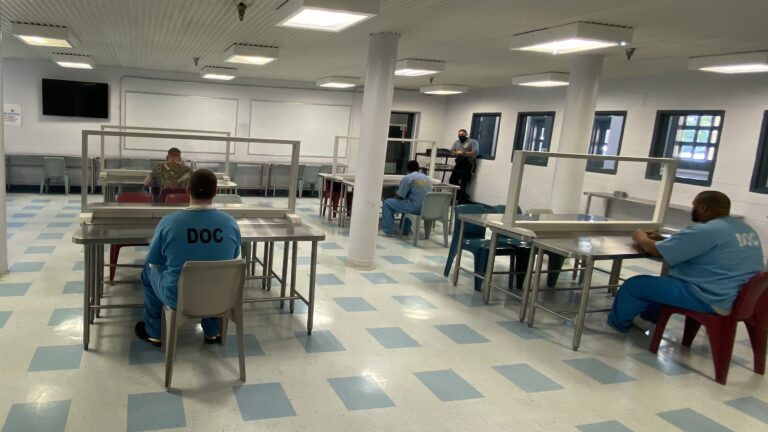Delaware reopens prison visitation to pre-pandemic levels
In-person visits have been either halted or limited during the last three years, depending on the severity of community spread of COVID-19.

Delaware prison officials have installed new plexiglass dividers in visitation areas like here at Morris Community Corrections Center in Dover. (Courtesy of DOC)
Nearly three years ago, prisoners in Delaware’s correctional system could look forward to a visit by as many as two adults and two children.
Then the coronavirus pandemic hit.
COVID-19 triggered outbreaks not only among the public at large but also inside facilities, with the virus frequently spreading among both those held behind bars and employees.
That led to visitation being halted or limited several times. When visitors were permitted, they first had to be screened for COVID-19 and test negative. In addition, authorities installed plexiglass barriers. They also either required or encouraged masks, depending on the severity of the virus at the time.
To cope with that ever-changing situation, prison leaders increased the availability of video visits. Those sessions proved quite popular, especially with people who had to travel from out of state or long distances within Delaware.
Since September, with infection rates relatively low, incarcerated men and women have been able to receive one adult and one child per visit.
Now, however, with community and facility spread at a minimum, those restrictions are fully eliminated.
The plexiglass is gone, though visitors will still be screened for COVID-19 and sent home if they test positive.
All facilities will accept up to two adults and two children for each visit. The only exception is Sussex Correctional Center, which will only permit up to three people — the pre-pandemic level.
Department of Correction Commissioner Monroe B. Hudson, Jr. says the move will “strengthen bonds with family and community supports” while still protecting staff and the 4,700 prisoners. As of this week, six people incarcerated in the state have active COVID-19 cases, and none have symptoms of illness, Hudson said.
Since March 2020, there have been nearly 3,000 COVID-19 cases among those held in state prisons, with 13 related deaths. Among staff, there’s been about 1,700 cases.
Haneef Salaam, a re-entry specialist who at one time was held in prison, said that the convenience of video visits aside, it’s critical for those behind bars to see their loved ones in person.
“It is their only true social interactions with individuals who do not work or live in the prison,’’ Salaam said.

Video calls do “give you more of a frequent contact, but it’s nothing like a live social interaction,” he said. “To have somebody there, physically there to see you, for you to lay eyes on, just helps a person socially, emotionally, and mentally while they’re going through such a hard thing like incarceration.”
Shane Troxler, the state’s chief of prisons, noted that even though more than 450,000 video visits have occurred during the last 12 months, face-to-face sessions are still the most beneficial.
“We take the communication with our incarcerated folks and their family members very seriously,’’ Troxler said. “We know how important it is for family reunification, for reentry, maintaining those healthy relationships with loved ones on the outside. We are anticipating an increase, and we’re ready for that.”

Visitation guidelines and scheduling information are posted on the state’s website.

Get daily updates from WHYY News!
WHYY is your source for fact-based, in-depth journalism and information. As a nonprofit organization, we rely on financial support from readers like you. Please give today.







